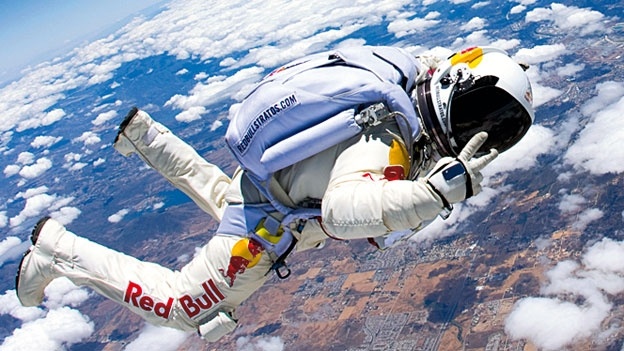A lot of us put skydiving at the top of our bucket lists as something we’d like to accomplish before we die. And for some daring enough, they want to set the bar a little higher, jumping from more extreme heights. Consider the previously held world record for world’s highest skydive: Joe Kittinger’s 102,800 feet (19.5 miles) jump in August of 1960, that allowed him to reach speeds up to 714 miles per hour (1,149 kilometers).
But for Felix Baumgartner, he had a different idea. How about a skydive from space, making it the first jump to break the through the sound barrier without an actual spacecraft? Of course, leave to Red Bull to be the ones to go ahead and sponsor such an attempt (Red Bull gives you wings, after all) as Baumgartner prepared for his 120,000 foot free fall above Roswell, New Mexico.
The suit: Along with Red Bull, engineers at the David Clark Company and the Department of Defense spent years preparing the suit that Baumgartner would wear to take the dive. The suit itself has different protective layers: the outermost layer made of Nomex that acts as an insulator, a second layer of mesh restraint that holds Baumgartner’s gas-filled bladder, and a breathable liner as the innermost part.
The System: A lot of risks come with jumping from that high up in the air, causing the human body to be unable to adapt to the atmospheric changes. Baumgartner’s suit has a built in oxygen breather that is constantly pumping at a pressure of 3.5 psi via the regulation of a pair of diaphragms. Once he reaches 35,000 feet the suit will depressurize and he will have a greater ability to move.
The Chest Pack: Also known as the suit’s hub, all of the necessary technology will operate here, including an HD video camera with a superwide 120-degree view, an internal measurement unit, lithium-ion batteries to power the visor’s deicing system and the chest pack itself, and then an accelerometer.
The Face Shield: It’s quite obvious the human face would be unable to withstand the extremities of this stunt; even just stepping out of the plane temperatures were –10 degrees Fahrenheit. But Baumgartner’s shield was insulated with extremely thin heat wires that were bonded right to the plastic-composite shield.
Baumgartner’s jump holds a lot of valuable information, despite its seeming ridiculousness. He told T3 magazine that “will achieve two things: the first is to provide valuable scientific data to space researchers. We’re seeking to achieve learnings and data that contribute to establishing safety protocols for astronauts and high-altitude aviators. This would be a remarkable legacy. The second: I will be the first man to jump at that altitude and the first to break the sound barrier in free fall.”
Before this Baumgartner had skydove around 2,500 times, so the 23 mile drop that took 8 minutes was probably a breeze for the skydiving professional—not to mention, the amazing view while passing through the atmospheric layers must have been quite a sight to see.
If given the chance, would you skydive 23 miles from space?
(via Popular Science & Red Bull; photo via T3)




